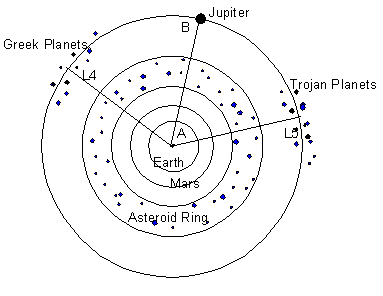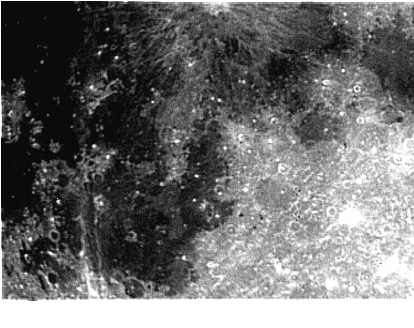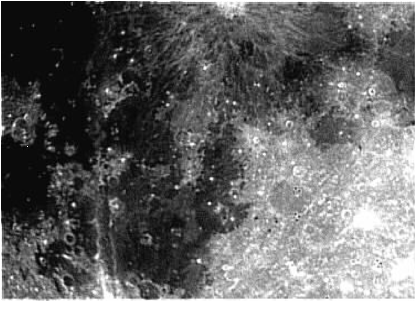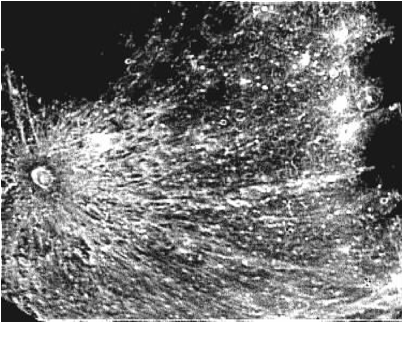 Figure
Caption: The Lagrangian Points L4 and L5 correspond to the location of
known objects, the Trojan Asteroids. (Illustration as from the Flammarion
Book of Astronomy). RLT
Figure
Caption: The Lagrangian Points L4 and L5 correspond to the location of
known objects, the Trojan Asteroids. (Illustration as from the Flammarion
Book of Astronomy). RLT

The monthly meeting of the Ogden Astronomical Society will be held Thursday November 13, 1997. Members will convene at 7:30 p.m. in the Ott Planetarium on the Weber State University campus.
This month's topic will be Black Holes.
Following a recent filmed presentation on the subject, members will indulge
in open discussion on this and other topics of choice.
Dr. Sohl has been more than excited over the response people have shown for the new planetarium program "Voyage to the Planets". This program is the most recent product produced entirely by Dr. Sohl and the Ott Planetarium, WSU, staff. "We have been having record attendance at the Wednesday night planetarium shows" John Sohl recently said. "We have routinely sold out both 7:30 p.m. and the overflow special showing at 8:30 p.m.".
The reservation slate is nearly full for November's shows which "means there will be additional 8:30 showings. OAS is always a great help", Dr. Sohl said.
The programs are on Wednesday nights with shows at 6:30, 7:30 and the recent 8:30 p.m. special showings. OAS members get in free when they assist with the post show star parties.
Two items which may be of interest to OAS members are scheduled in November at Weber State University.
On Friday November 7 at 7:30 p.m. this year's Ritchey Lecture is a non-astronomy related, but no less interesting talk on "The Ebola Virus and its Potential for Disaster". The presenters are Col.'s Gerald P. Jaax and Nancy K. Jaax, both Dr.'s of Veterinary Medicine. These two scientists managed the brief and potentially devastating outbreaks of the disease that once occurred in the U.S.
Another presentation will be held on Thursday
November 20 at 10:30 a.m. (that's a.m.). Dr. Brian Muirhead, Deputy Project
Manager for the Mars Pathfinder Project, will present a talk, "Greetings
from Mars". The talk will be in the Union Building Ballroom which is on
the U.B. top floor, west end of the west wing.
Those OAS members wishing to subscribe to or renew their subscription to Astronomy magazine will have this final chance to do so at the November 13 meeting.
Club Treasurer, Doug Say, has not yet sent in the order because so few signed up last month. He will be available at this meeting to take the money for your subscription. The forms will be sent in the following day. Renewals for the special club price of $24.00 will not be available again until next year at this time. This is a $12.00 savings to members.
The regular meeting of the OAS convened at 7:30 p.m. in the Ott Planetarium. Club Pres. Steve Peterson opened with welcomes.
In an effort to save club funds, Steve suggested that those members with access to the www may chose to discontinue the monthly hard copy of the Star Diagonal and opt for reading it on the club web site. Notify Bob T. if you are interested.
Dr. Sohl can use all the help offered by members who attend the post planetarium show star parties. The shows are being heavily attended.
Various groups requesting OAS star parties for their events will soon be paying a minimum of $50.00 for members to bring out their telescopes. The money is used for the club telescope, B.O.B., fund and for general operating costs.
John Sohl took the floor to present the evening's topic. He discussed the recently successful Project Starshine where OAS members contributed their time and telescopes for 150 local teachers. While attending the Hutcheson Conference in Kansas, John had the opportunity to visit The Cosmosphere Museum. A breathtaking collection of valuable science and space artifacts, no one should miss this when in Kansas.
John then discussed and ran a video on the Saturn Cassini project.
The meeting adjourned for casual discussion at 9:30 p.m.
Bob Tillotson, Secretary
Isn't it wonderful how astronomers can predict astronomical events with astonishing accuracy? We know when and where on the surface of the Earth a solar eclipse will occur. We know when a lunar eclipse will occur, and how much of the moon's surface will be in shadow. We know when and where the planets will be as they orbit the Sun. But, how accurately can astronomers predict these events?
Let's go back in time to when Isaac Newton formulated his law of universal gravitation. Newton's law was a complete answer to the "two-body problem" (at least in classical physics, where relativity and quantum theory are ignored). Using classical physics (Newtonian physics), and assuming there were only two objects in the universe, then the gravitational interactions of these two bodies could be predicted exactly.
However, the universe doesn't contain only two bodies.
It contains uncounted trillions. The next step up is to take all of these
objects into account and solve the "three-body problem". Given three bodies
in the universe, with known position and motion, what will their positions
be at all given times?
 Figure
Caption: The Lagrangian Points L4 and L5 correspond to the location of
known objects, the Trojan Asteroids. (Illustration as from the Flammarion
Book of Astronomy). RLT
Figure
Caption: The Lagrangian Points L4 and L5 correspond to the location of
known objects, the Trojan Asteroids. (Illustration as from the Flammarion
Book of Astronomy). RLT
And right there, astronomers find a problem. For that reason there is no use going on to the "octillion-body problem" represented by the real universe. Fortunately, astronomers are not halted in their work. For example, suppose astronomers wanted to calculate the orbit of the Earth around the Sun so that their relative positions could be calculated for the next million years. If the Sun and the Earth were all that existed, the problem would be a trivial one to solve. But the gravitational influence of the Moon and the other planets must be considered, and for complete exactness the stars must also be considered.
Fortunately, the sun is so massive that its gravitational influence drowns out all others. This means that the orbit obtained for the two-body problem is almost right.
The man who most closely approached the "right" answer was the French astronomer
Joseph Louis Lagrange. In 1772, he found certain situations where the three-body problem could be solved.
Imagine two bodies in space with the mass of body A at least 25.8 times as massive as body B (something like the orbit of Jupiter around the Sun, where the Sun is body A and Jupiter is body B). Next imagine a third body , C, of insignificant mass. Lagrange found that it was possible to place body C at certain points in relationship to bodies A and B, so that C would revolve about A in perfect step with B. In that way the positions of all three bodies could be determined for all times.
There are five points where body C can be placed. They are naturally enough called "Lagrangian points". Three of them, L1, L2, and L3, are on the line connecting A and B. The first, L1, places small body C between A and B. Both L2 and L3 also lie on the line connecting A and B, but on the other side of A in the first case and on the other side of B in the second case.
These three Lagrangian points are not important because they are unstable. However, the final two points are not on the line connecting A and B. Instead, they form equilateral triangles with A and B. As B revolves around A, L4 is the point that moves before B at a constant angle of 60 degrees, while L5 moves behind it at a constant 60 degrees.
At the time Lagrange worked this out, there were no examples of objects in these two Lagrangian points anywhere in the universe. Of course, in recent times we have actually observed objects in our solar system that occupy
these two Lagrangian points. For example, asteroids orbiting Jupiter, and dust particles orbiting Earth. In the movie 2010 Odyssey Two, the position of the Monolith orbiting Jupiter was at an L point. Taken from the book Asimov on Astronomy, by Isaac Asimov.
The three CCD images below
were taken between the nights of October 13 through 15, 1997. Using my
ST-6 camera and the 8-inch Celestron, two WSU students of Dr. Adam Johnston
took these shots of the moon. The students have never used telescopic equipment
before. They could not believe their results. Even considering there was
a high thin cloud layer, the students took the photos after only a few
minutes of instruction. We used a Hartman Mast with 2 1-inch holes to focus
and stop down the telescope.


Figures 1 and 2 are taken
of approximately the same areas of the moon's surface. They center on the
Sea of Clouds (Mare Nubium), about 15 West Longitude and -15 South Latitude.
The bright ray crater bisected at the top is Copernicus.

Figure 3 is of the southern
area of the moon with the beautiful Tyco crater at left. The limb of the
moon is at the bottom left corner.
Elgie/RLT